Dna Replication Drawing Answer Key
Looking for a student learning guide? It's linked in the main menu for your course. Use the "Courses" menu above.
1. Introduction
In the previous tutorial, we looked at the structure of DNA.

As we'll see in this tutorial, DNA's structure lends itself to replication. That's essential for a molecule that gets passed from one generation to the next during reproduction, and from one cell to the next as an organism grows and develops.
2. Replication means "copying DNA"
Replication involves making two new molecules of "daughter" DNA from one molecule of "parent" DNA.
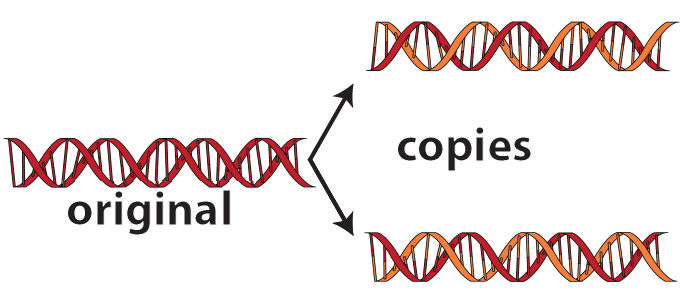
Here's an explanation, in verse, of the key idea behind replication.
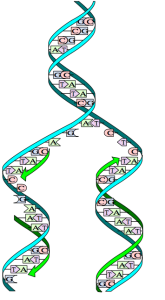

DNA's structure with its bases complementary
Makes replication easy, but not quite elementary
Since A only bonds with T and C with G
The Double Helix seems to copy naturally,
Or as Crick and Watson said:
"It has not escaped our notice that the specific pairing
We have postulated immediately suggests
A possible copying mechanism
For the genetic material"
James Watson and Francis Crick (along with Maurice Wilkins) were the co-discoverers of the structure of DNA. Their work relied heavily on the work of a fourth scientist, Rosalind Franklin. The quote above is from the conclusion to the paper Watson and Crick wrote in the science journalNature in 1953, first describing the structure and chemistry of DNA.
3. DuringDNA Replication, each strand serves as a template for the synthesis of a complementary strand
Here's a big picture view of what happens during DNA Replication.
- The strands separate

Step 1: the double helix separates into two single strands along part of its length - With bases exposed, each single strand now serves as a template for synthesis of a new strand. A template is "a molecule … that serves as a pattern for the generation of another macromolecule" (meriam-webster,on-line, m-w.com).

Step 2: Each strand serves as a template for synthesis of a new strand - Following the base pairing rules, new complementary nucleotides form hydrogen bonds with nucleotides on the template strands.
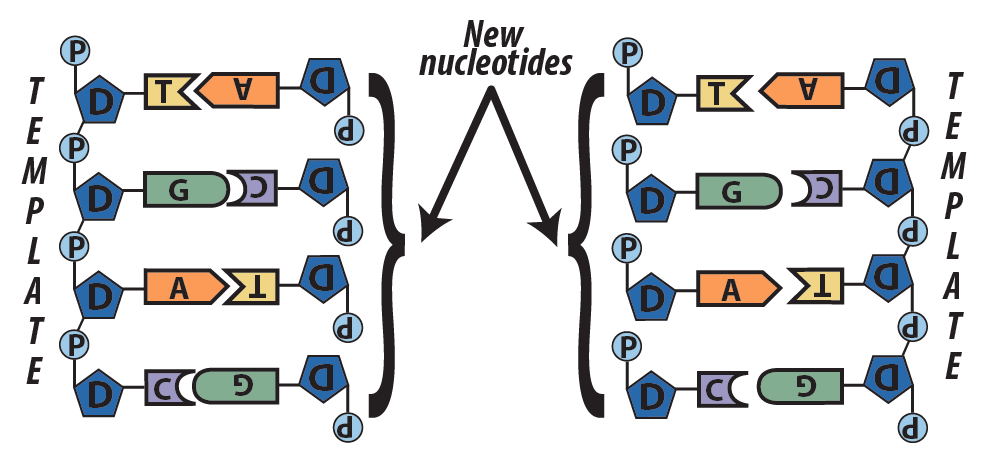
Step 3: new complementary nucleotides bind with the parent strands - Enzymes seal covalent bonds between the sugars and the phosphates of adjacent nucleotides.
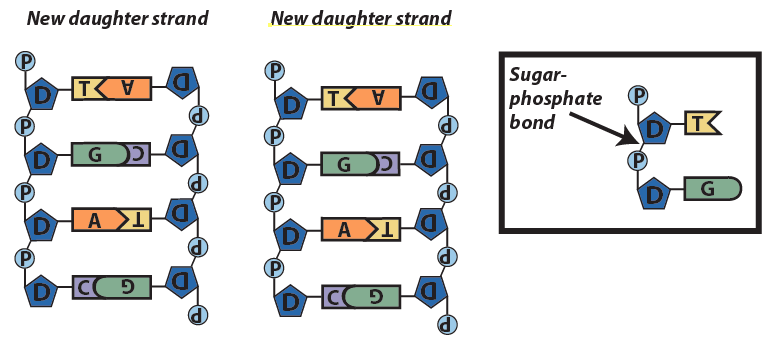
Step 4: Enzymes seal the new strands together with sugar-phosphate bonds.
This model of replication is called semi-conservative: in each new strand, one strand is old, and one strand is new.

Here's the same explanation in verse:
You first unzip the DNA in one or more places,
Breaking hydrogen bonds to separate the bases.
Each resulting single strand serves as a template,
Allowing enzymes to replicate
New strands with complementary bases that match
And through hydrogen bonds these bases attach
Each nucleotide now bonds to the next
Through a sugar-phosphate bond they connect
Meselsohn and Stahl proved in '58(read about their experiment)
That this is how the double helix replicates
One strand new, the parent strand preserved,
In other words the whole thing is semi-conserved
4. Checking Understanding: DNA Replication (the big picture)
5. How DNA replication occurs in cells

When you look at model or diagram of DNA, and go about the task of replicating it, you can see the bases, think of the base pairing rules, and manipulate the model (pulling it apart, adding new nucleotides) to create daughter strands from the parent strand. How can cells, which can't see or think, perform this task?
Cells do this all by enzymes, which have to do everything by touch and feel. In what follows, I'm going to break the process down into ten steps.
1. Replication begins as an enzyme called DNA helicase (B) finds a sequence of bases called the origin of replication (A). As its name indicates, DNA helicase breaks open the double helix by breaking the hydrogen bonds between complementary bases..

2. The structure that results from the opening of the helix is called a replication fork.
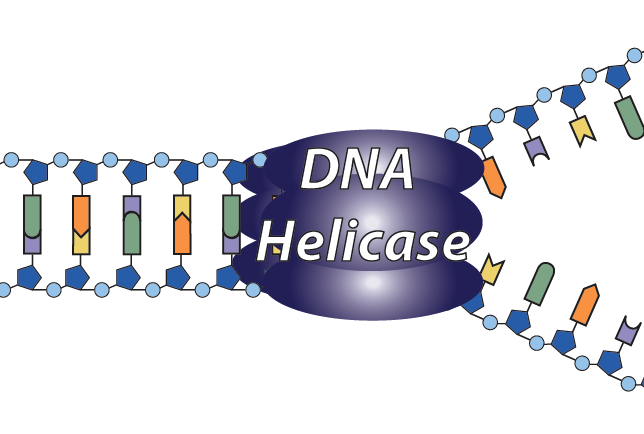
3. Replication forks are always created in pairs, creating a replication bubble (the entire structure below) . In the replication bubble below, the original parent DNA is at C , helicase is at B, newly synthesized DNA is shown in light blue at "D." The two replication forks are at "E," and the origin of replication is at "A." In case you were wondering, we'll get to the red nucleotides and the direction of the arrows in just a bit.
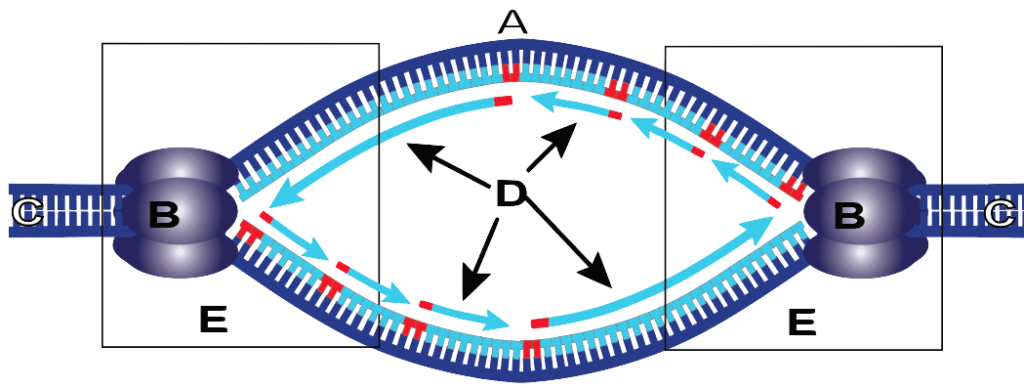
Check out this amazing electron micrograph: What do you think each of the white arrows is pointing to?
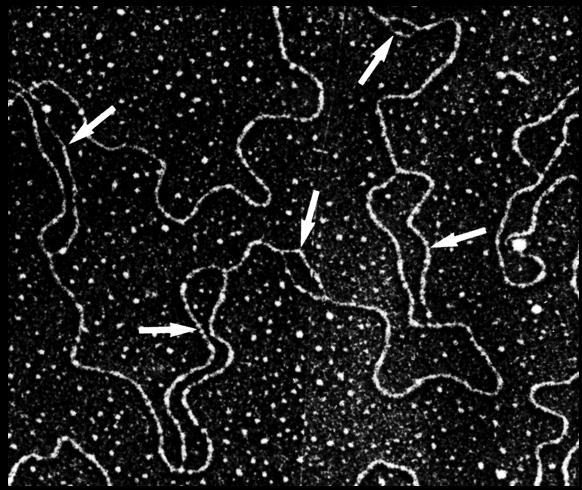
4. To keep the double helix from rewinding, single strand binding proteins (F) bind with the parent strand just behind helicase.
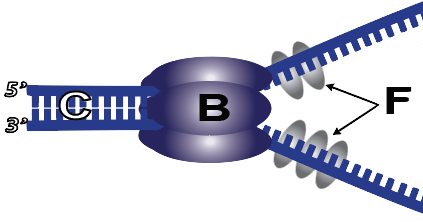
5. With the nitrogenous bases of the template (parent) strand exposed, the cell can now create complementary DNA on the daughter strand. The enzyme that does this is DNA polymerase III ("G" below). DNA polymerase IIIrides along the parent strand. As new nucleotides form hydrogen bonds with their complements on the template strand, DNA polymerase III catalyzes a sugar-phosphate bond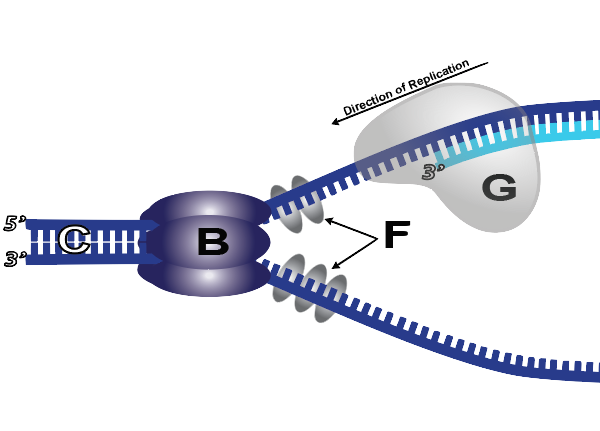 between the growing strand and the new nucleotide at the 3′ end of the growing strand. (See the previous tutorial for a review of 5′ and 3′). Note that DNA polymerase "knows" which nucleotide is the right one based on its fit with the nucleotide on the parent strand. The right nucleotide (A with T, for example) will "feel right," causing DNA polymerase's active site to change shape (by induced fit) and catalyze the bond.
between the growing strand and the new nucleotide at the 3′ end of the growing strand. (See the previous tutorial for a review of 5′ and 3′). Note that DNA polymerase "knows" which nucleotide is the right one based on its fit with the nucleotide on the parent strand. The right nucleotide (A with T, for example) will "feel right," causing DNA polymerase's active site to change shape (by induced fit) and catalyze the bond.
6. DNA polymerase III can attach new nucleotides to a growing strand, but it can't add a new nucleotide if there's nothing to attach to. As a result, DNA polymerase III can't initiate replication. Instead, another enzyme called primase (I) adds a short RNA primer (H). Once in place, DNA polymerase III can continue the replication process.
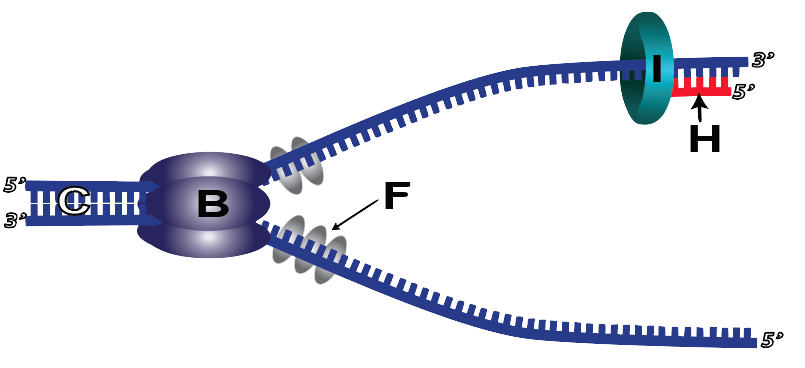
8. Because DNA polymerase III can only add new nucleotides at the 3′ end, a few more complications occur during DNA replication. The first has to do with what are called the leading and lagging strands.
In the diagram below you see a replication bubble. The two DNA polymerase III enzymes that are following the opening replication forks are synthesizing new complementary DNA strands, and attaching new nucleotides at the 3′ end. I've marked this new DNA with the letter "J." This strand is known as the leading strand.
But how can DNA polymerase III synthesize a complementary DNA strand where I've put a question mark? That would require DNA polymerase III to add new nucleotides at the 5′ end, which it can't do.
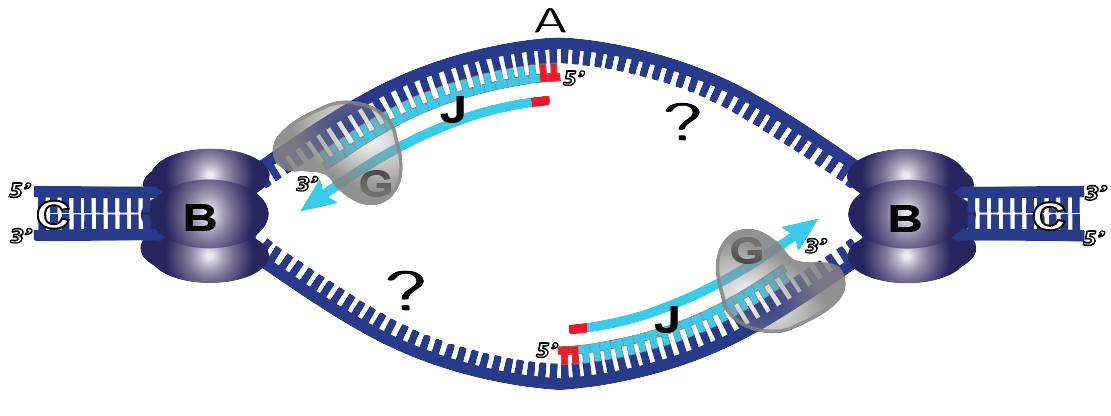
The strand where I've put a question mark is known as the lagging strand. It's where synthesis moves away from the opening replication fork. This is in contrast to J, where DNA synthesis follows the replication fork. The solution for the lagging strand is for DNA synthesis to proceed in fragments, shown below at "K."
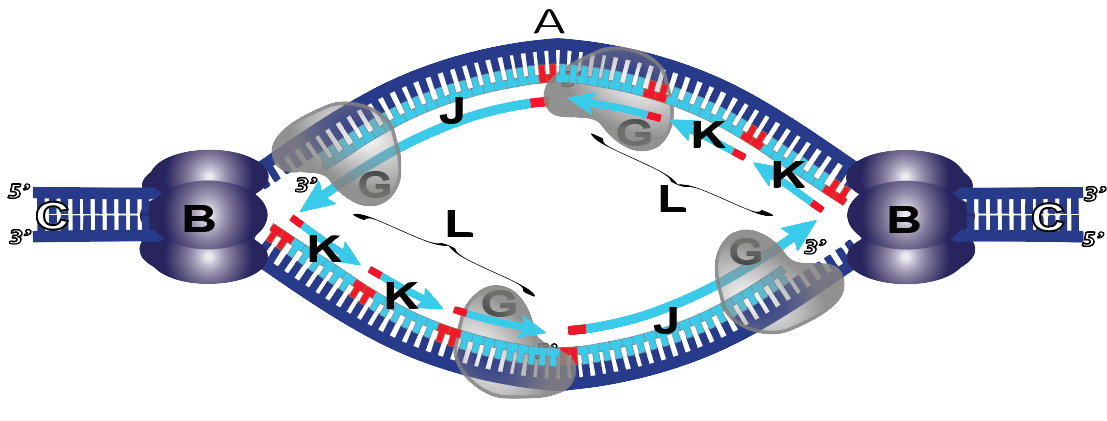
What you can see above is that on the leading strand (J), DNA synthesis is continuous. By contrast, in the lagging strand (L), DNA synthesis is fragmentary. Try to imagine the following: as the replication fork opens, Primase lays down its RNA primer. Then DNA polymerase comes in and lays down a short fragment of new DNA.When it reaches the RNA primer from another fragment, the DNA polymerase stops. Note that in honor of their discoverer,Reiji Okazaki, these fragments are called "Okazaki fragments."
9. Because of Okazaki fragments and primers, there's a lot of cleanup required at the end of the process. Cleanup begins as an enzyme called DNA polymerase I (shown at K below) comes and removes the primer, replacing RNA nucleotides with DNA nucleotides.

10. But even after the primer is removed, there's still a gap (because DNA polymerase 1 can only add nucleotides to an existing strand: it can't connect two strands together). To do this, a final enzyme, DNA ligase (N), comes and closes the gap between fragments.
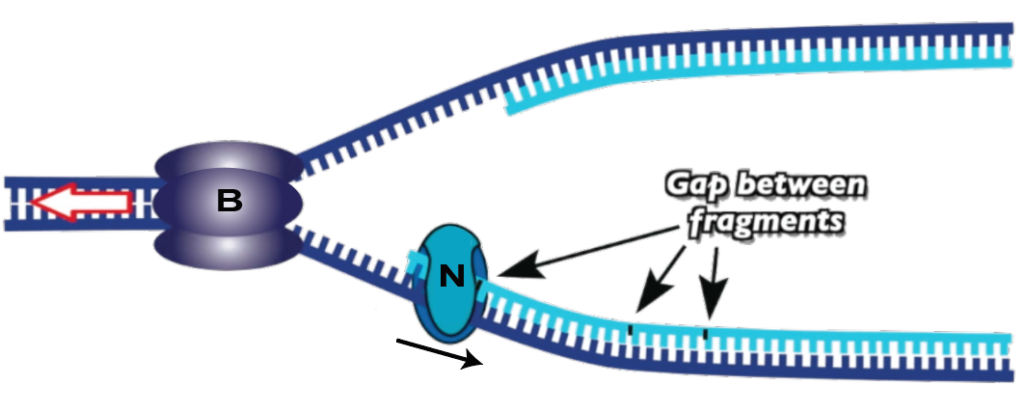
6. And Here's What it Really Looks Like
The process I described above is a great model for understanding DNA replication. But it's actually much more complex. Watch this computer animation from the Howard Hughes Medical Institute.
7. Quiz: DNA Replication (with some DNA structure review)
The quiz below uses a combination of diagrams, multiple choice, and fill-in-the blanks to help you consolidate your knowledge of DNA replication, as well as DNA structure.
8. DNA Replication: Interactive Lyrics
I'm assuming you've already watched my DNA Replication music video. If not, please click here.
9. DNA Replication Flashcards
Links
- Transcription and Translation (next series of molecular genetics tutorials)
- DNA Structure and Replication Main Menu
- DNA Replication Rap (a salsa-themed music video)
Dna Replication Drawing Answer Key
Source: https://learn-biology.com/ap-biology/module-13-dna-discovery-structure-and-replication-menu/dna-replication-ap-level-tutorial/
Posted by: cordonearmeard.blogspot.com

0 Response to "Dna Replication Drawing Answer Key"
Post a Comment